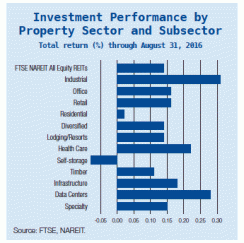To view a PDF of the report, click here.
By Richard Westlund
Rising demand from global buyers and a long-awaited classification change by Standard & Poor’s have combined to coax greater interest in both public real estate investment trusts (REITs) and private real estate assets from institutional investors this fall.
“For the past several years, there has been a flow of global capital into U.S. real estate,” says Amy Price, president and chief operating officer at Bentall Kennedy (U.S.). “In a low-interest-rate environment, U.S. real estate may be seen as a safe haven for investors with opportunities for higher returns than fixed-income securities and less volatility than equities.”

| 
|
| Brad Case, National Association of Real Estate Investment Trusts (NAREIT) | Amy Price, Bentall Kennedy (U.S.) |
In August, Standard & Poor’s Financial Services implemented a long-planned change to its Global Industry Classification Standard, creating a new real estate sector for equity REITs and real estate management and development companies, which had previously been included in the financial sector.
“This step will raise real estate’s profile as a distinct market segment, bringing new visibility and capital to this asset class,” says Brad Case, senior vice president of research and industry information at the National Association of Real Estate Investment Trusts (NAREIT). “Investors will now be able to follow this asset class and track its performance.”
Case expects this shift will lead to a decline in REIT trading volatility and a lower short-term correlation with equity market trends — attractive characteristics in a risk-averse time. “Much of the money traditionally invested in REITs has been handled by mutual fund and exchange-traded fund (ETF) managers who focus on the entire financial sector,” he says. “We think new real estate investment funds will be offered by managers who have knowledge and experience in this specific sector, thereby reducing the uncertainty over asset values and lowering volatility for this sector.”
Looking at opportunities in the U.S. real estate market, Case says there is no indication of a cyclical downturn this fall. Virtually all equity REIT categories generated double-digit returns through the first eight months of 2016, he notes (see chart): “Industrial, data-center and cell-tower infrastructure REITs have all done well this year due to the growth of the e-commerce supply chain.”

Medical-office properties form an especially interesting asset class because their valuation is strongly driven by the aging of America and shifts in how medical services are delivered to patients, says Bentall Kennedy’s Price. “We believe there will be ongoing opportunities in acquisitions and new development,” she says. “We also remain positive about the multifamily sector, despite the widely reported concerns about overbuilding. We see strong long-term demand for apartments, not just from Millennials but the younger generation now in their teens.”
The increased attention to listed strategies, which offer high liquidity, does not come at the expense of direct ownership. “Private real estate can offer investors a longer-term investment horizon, portfolio diversification and potential for a lower level of volatility,” says Price.
Bentall Kennedy takes a long-range investing approach based on fundamentals such as demographics, job growth and attractiveness to young professionals and families. “We look closely at real estate in markets known for innovation and entrepreneurship, such as San Francisco, Boston and Seattle,” Price notes. “Immigration is also an important market driver, especially in the Millennial generation, which is a combination of U.S. and foreign-born Americans.”
Looking further ahead, Price argues that a sustainable property-investing strategy can reduce risk and increase value over the long term. “While the green building trend is gaining momentum, it has not yet been embraced as a way to create value,” she says. “But as markets tighten, buildings with lower expenses and higher tenant satisfaction should compete more effectively in the local market.”





